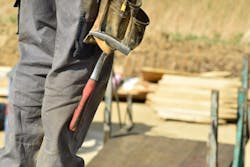Can Technology Solve the Labor Shortage?
It’s taken some time, but it seems like the home building industry is finally approaching critical mass in dealing with the labor shortage. At the IBS/KBIS show last month, the issue was front and center in a variety of ways. NAHB and NKBA set the tone for the trade show by kicking off at the opening ceremonies with a presentation by Norm Abram of This Old House fame, who spoke about the importance of solving the issue and described initiatives such as the Skilled Labor Fund campaign, an industrywide effort to address the shortage of skilled labor in residential construction. Additional events throughout the show gave attendees the opportunity to increase their awareness of possible solutions and learn what they can do to mitigate the effects of the shortage and bring new blood into the industry.
At the show, it became clear that building product manufacturers are continuing to step up in a big way to find solutions to counteract the shrinking labor force. Many have designed and put into the marketplace new products that require fewer workers and less time to install. A number of these involve paring weight from products and prepping them in advance so that less work needs to be done on the actual jobsite. LP’s siding and trim division, for example, has been working to make its products more contractor-friendly. “Our product comes pre-primed and is very lightweight, so one person can carry two or three 16-foot trim boards at a time,” LP brand manager Amy Lindholm told our sister publication PRODUCTS. “It’s really important to gain labor savings, even if it’s just a little less handling of the product on the jobsite. Even the most minute savings add up over time.”
Another type of labor-saving product is AeroBarrier, an aerosol envelope sealing system, which was judged the Most Innovative Building Material Product, as well as Best in Show, by the NAHB in its sixth annual Best of IBS Awards. It is being called one of the decade’s most disruptive building products. The AeroBarrier system, which was used in the 2018 New American Home, reduces air leakage to nearly zero, helping builders achieve the most stringent energy efficiency standards, such as LEED, Passive House, ZERH, and the 2015 IECC. Arizona-based Mandalay Homes has been testing the product on its new homes for a while. Mandalay, a production builder and an eight-time winner of the Department of Energy’s Housing Innovation Awards, described the product as “the key for us building net zero homes as a standard feature.” Moreover, the company says, in their test, two laborers sealed a 2,200-square-foot, three-bedroom house in less than three hours.
Also introduced at IBS this year was Covestro’s PUReWall, a panelized wall that combines insulation and a weather-resistant barrier within a complete, structural, high-efficiency wall assembly. Polyisocyanurate continuous insulation on the exterior and spray polyurethane foam (SPF) in the wall cavity of PUReWall panels replace traditional exterior sheathing and house wrap. The panels are manufactured in a controlled environment at Covestro’s panelization facilities and are delivered ready to install at the builder’s site. The company says this “alleviates jobsite workforce bottlenecks, produces less waste, requires less wood use, and results in a faster framing time for builders.” In addition, Covestro says the panels are able to meet current energy codes and can be designed to perform well beyond them, even to the point of net zero energy and Passive House requirements.
These new products and others like them, developed to streamline the building process, slash field installation time, and improve productivity on the jobsite, will go a long way toward helping alleviate the industry’s labor problems. But not all the way. For that, we’ll need a major shift in how our workforce views careers in construction or a fundamental change in the way we build homes.

